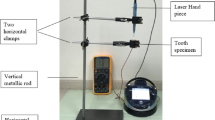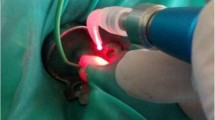Abstract
Objective
The current study aimed to evaluate the temperature rise in the dental pulp during treatment of dentin with 445-nm diode laser.
Materials and methods
Ten single-rooted human premolar teeth were randomly enumerated into 1 to 10. Teeth were embedded in a resin block, and a thermocouple was inserted into the pulp chamber. Cervical third of the crown were irradiated with 1, 1.5, 2, 2.5, and 3 W at time of irradiation of 10, 15, 30, and 60 s (CW, Non-contact mode), while immersed in a 37 °C thermal bath.
Results
The maximum mean temperature rise in the dental pulp was 10.6 °C achieved after irradiation with 3 W for 60 s and the lowest temperature increase achieved was 0.3 °C with 1 W for 10 s.
Conclusion
Using the 445-nm diode laser, 0.2–1 W, CW up to 60 s; 1.5 W, CW up to 15 s; 2 W, CW, 10 s; and 2.5 W,CW, 10 s are considered biologically safe parameters for the dental pulp during dentine hypersensitivity treatment.




Similar content being viewed by others
References
Taha S, Clarkson BH (eds) Clinician’s guide to the diagnosis and management of tooth sensitivity, p 1. https://www.morawa.at/annotstream/2244008532646/PDF/Taha-Sahar/Clinicians-Guide-to-the-Diagnosis-and-Management-of-Tooth-Sensitivity.pdf. Accessed 28 Jan 2020
(2003) Canadian Advisory Board on Dentin Hypersensitivity Consensus-based recommendations for the diagnosis and management of dentin hypersensitivity. J Can Dent Assoc 69:221–226. https://www.academia.edu/35404564/_Canadian_Advisory_Board_On_Dentine_Hypersesitivity. Accessed 28 Jan 2020
Pashley D, Tay FR, Haywood VB, Collins MA, Drisko CL (2008) Consensus-based recommendations for the diagnosis and management of dentin hypersensitivity. Comp Contin Educ Dent 29(8 Suppl):1S–35S
Irwin CR, McCusker P (1997) Prevalence of dentine hypersensitivity in a general dental population. J Ir Dent Assoc 43(1):7–9
van der Weijden FN, van Loveren C, Slot DE, van der Weijden GA [Preventive dentistry 3. Prevalence, aetiology and diagnosis of dentine (hyper)sensitivity]. https://www.pubmed.ncbi.nlm.nih.gov/28186512/. Accessed 28 Jan 2020
Smith WA, Marchan S, Rafeek RN (2008) The prevalence and severity of non-carious cervical lesions in a group of patients attending a university hospital in Trinidad. J Oral Rehabil 35(2):128–134
Addy M, Embery G, Edgar WM, Orchardson R, eds (2000) Dentine hypersensitivity: definition, prevalence, distribution and etiology. Tooth wear and sensitivity: clinical advances in restorative dentistry. London: Martin Dunitz, 239–248
Roberson T, Heymann H, Swift E (2006) Art and science of operative dentistry, vol 268, 8th edn, p 292
Verma SK, Maheshwari S, Singh RK, Chaudhari PK Laser in dentistry: an innovative tool in modern dental practice. https://www.pubmed.ncbi.nlm.nih.gov/23833485/. Accessed 28 Jan 2020
Umberto R, Claudia R, Gaspare P, Gianluca T, Alessandro del V Treatment of dentine hypersensitivity by diode laser: a clinical study. https://www.ncbi.nlm.nih.gov/pmc/articles/PMC3389731/. Accessed 28 Jan 2020
Braun A, Berthold M, Frankenberger R (2015) The 445-nm semiconductor laser in dentistry—introduction of a new wavelength. 66(2):205–211 205. https://www.blog.dentsplysirona.com/wp-content/uploads/2015/04/SD_Braun_QD_15_02_ENG_SCREEN_SCREEN-mWM.pdf. Accessed 28 Jan 2020
Zach L, Cohen G (1965) Pulp response to externally applied heat. Oral Surg Oral Med Oral Pathol 19:515–530 [Links]
Eriksson A, Albrektsson T, Grane B, McQueen D (1982) Thermal injury to bone. A vital microscopic description of heat effects. Int J Oral Surg 11:115–121
Jakubinek MB, Samarasekera CJ, White MA (2006) Elephantivory: a low thermal conductivity, high strength nanocomposite. J Mater Res 21:287–292
Trushkowsky R, Oquendo A (2011) Treatment of dentine hypersensitivity. Dent Clin N Am 55(3):599–608
Porto I, Andrade A, Montes M (2009) Diagnosis and treatment of dentinal hypersensitivity. J Oral Sci 51(3):323–332
Kreisler M, Al-Haj H, D’Hoedt B (2002) Intrapulpal temperature changes during root surface irradiation with an 809-nm GaAlAs laser. Oral Surg Oral Med Oral Pathol Oral Radiol Endod 93(730–735):28
Franzen R, Rashidisangsary B, Ozturan S, Vanweersch L, Gutknecht N Intrapulpal temperature changes during root surface irradiation with dual-wavelength laser (2780 and 940 nm): in vitro study. https://www.spiedigitallibrary.org/journals/journal-of-biomedical-optics/volume-20/issue-01/018002/Intrapulpal-temperature-changes-duringroot-surface-irradiation-with-dual-wavelength/10.1117/1.JBO.20.1.018002.full?SSO=1. Accessed 28 Jan 2020
Liu Y, Gao J, Gao Y, Sh XU, Zhan X, Wu B (2013) In vitro study of dentin hypersensitivity treated by 980-nm diode laser. J Lasers Med Sci 4(3):111–119
Umana M, Heysselaer D, Tielemans M, Compere P, Zeinoun T, Nammour S Dentinal tubules sealing by means of diode lasers (810 and 980 nm): a preliminary in vitro study. https://pubmed.ncbi.nlm.nih.gov/23756100/. Accessed 28 Jan 2020
Jukic Krmek S, Miletic I, Simeon P, Prpic Mehicic G, Anic I, Radisic B (2009) The temperature changes in the pulp chamber during cavity preparation with the Er: YAG laser using a very short pulse. Photomed Laser Surg 27:351–355
Author information
Authors and Affiliations
Corresponding author
Ethics declarations
Conflict of interest
The authors declare that they have no conflict of interest.
Ethical approval
This article does not contain any studies with human participants or animals performed by any of the authors.
Informed consent
Informed consent was obtained from all individual participants included in the study.
Additional information
Publisher’s note
Springer Nature remains neutral with regard to jurisdictional claims in published maps and institutional affiliations.
Rights and permissions
About this article
Cite this article
Morsi, A., Haidary, D., Franzen, R. et al. Intra-pulpal temperature evaluation during diode laser (445 nm) irradiation for treatment of dentine hypersensitivity: in vitro a pilot study. Laser Dent Sci 4, 139–144 (2020). https://doi.org/10.1007/s41547-020-00085-9
Received:
Accepted:
Published:
Issue Date:
DOI: https://doi.org/10.1007/s41547-020-00085-9




